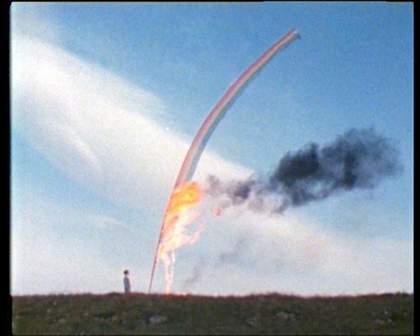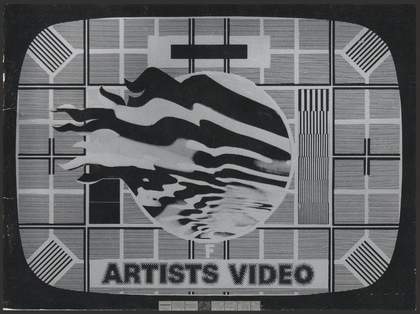Focusing on pioneering works produced in Europe (1960-1980), this two-day programme questions the possibilities that emerge from this distortion. These works were either made using synthesizers, largely designed for projection, or intended for television and shot on 16mm film.
Day two presents a series of works made for television, first filmed on 16mm and subsequently transferred to video.
Part of Tate Modern Lates on 29 November 2024. Tickets bookable from 14.00 on the day via the Tate Modern Lates page
Programme
- On the CRT monitor at the entrance: Sanja Iveković Instructions No.1 1976. Video, black and white, sound, 6min
- Looping on the cinema screen: Charlotte Johannesson Untitled 1981-1985. Digital computer graphics (slide show of 15 images)
- Introduction by François Bovier
- Martial Raysse Portrait Electro Machin Chose 1967. Video transferred to 16 mm, black and white, 9 min
- Dieter Meier, One minute (Autoportrait) 1969. 16 mm
- Helena Almeida, Ouve-me 1979. Super 8 transferred to video, black and white, silent, 4 min
- Pawel Kwiek, Studio situation or Video A 1973. Video, black and white, sound, 3 min
- VALIE EXPORT, Facing a Family 1972. Video, black and white, sound, 4 min
- Rúrí, Rainbow 1983. 16mm transferred to video, colour, sound, 1 min
- Aldo Tambellini and Otto Piene, Black Gate Cologne: A Light Play 1968. Video, black and white, sound, 29 min
- E. M. de Melo e Castro Roda Lume 1968. Video, black and white, sound, 2 min
- Lecture by Laura Leuzzi, followed by a conversation with Rúrí
This two day programme focuses on early European video art. The works included were either made using synthesizers or intended for television and shot on film. In Europe, video technology first became accessible in the 1960s. Artists experimented freely with this, bridging the gap between the visual arts and other practices. Coming from backgrounds as diverse as performance, dance, music, painting, sculpture and film, they worked beyond and across media.
This second chapter presents a series of works made for television, first filmed on 16mm and later transferred to video.
In the first work, painter and sculptor Martial Raysse manipulates images, including the portrait of singer Zouzou. In his short 1 Minute produced for Swiss television, Dieter Meier presents a self-portrait against the backdrop of a talking clock while, in Portugal, Helena Almeida speaks about the constraints of women in a performance for the camera. Pawel Kwiek gives instructions to operators in a live performance for the Polish Television and VALIE EXPORT, working with the Austrian broadcasting company, deconstructs the role of television in family settings. Rúrí’s Rainbow documents a performance where a rainbow made of fabric is burnt. Two rare works close this programme. Otto Piene and Aldo Tambellini’s is considered the first large-scale television broadcast made by artists. It unfolds as a live event exploring light, participation and real-time transmission. Roda Lume is a lost video poem remade by E.M. de Melo e Castro.
Before and after each screening, Charlotte Johannesson's computer generated slides infiltrate the cinema. A monitor at the entrance shows Sanja Iveković’s Instructions I, which deviates the make-up act through a feminist self-portrait.
This two day programme has been curated with Stéphanie Serra and François Bovier
For more information visit: www.videoarteurope.com


